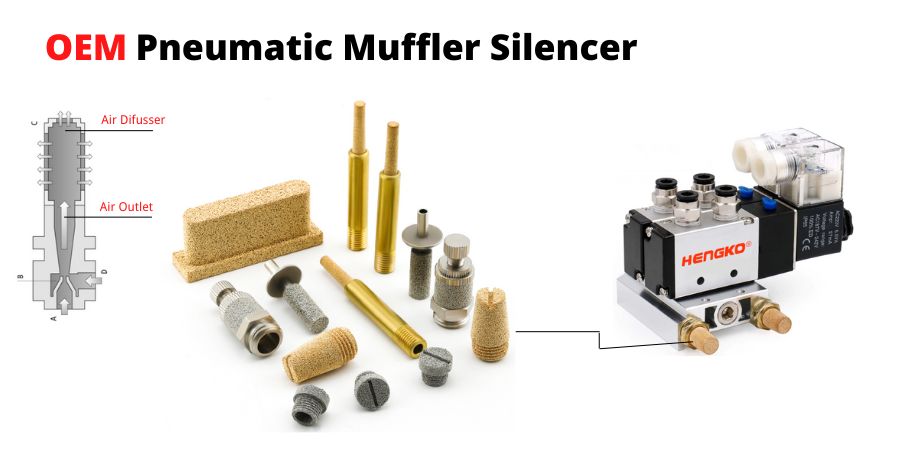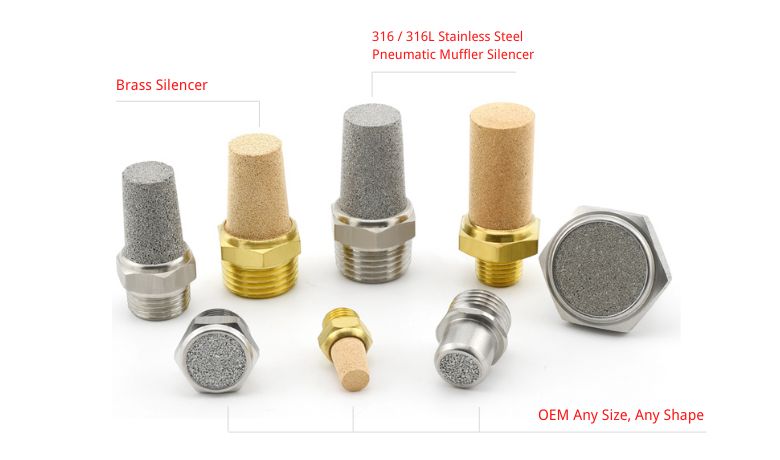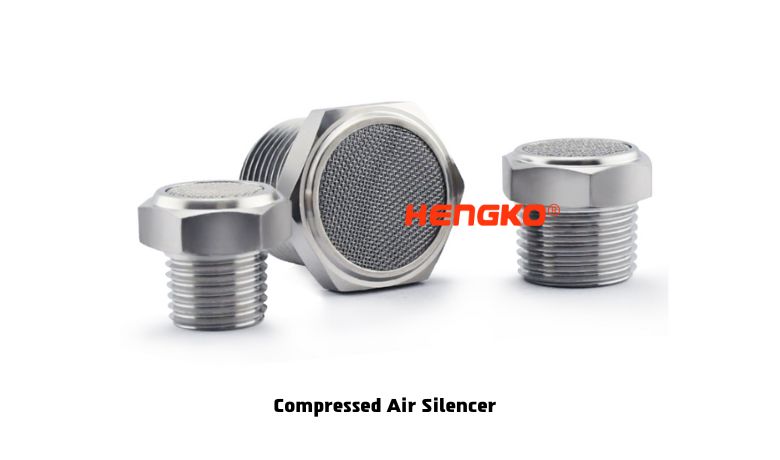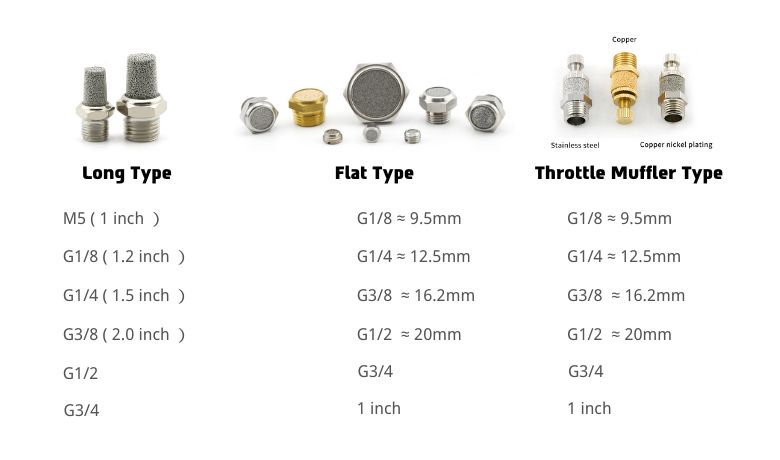-
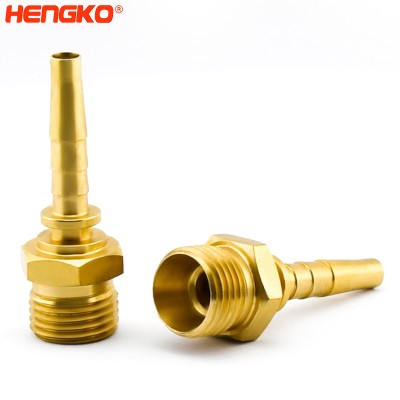
HENGKO Affordable porous powder metal sintered ax100 air pneumatic muffler
Pneumatic Sintered Mufflers Filters utitlize porous sintered bronze filter elements secured to standard pipe fittings. These compact and inexpensive mufflers...
View Detail -
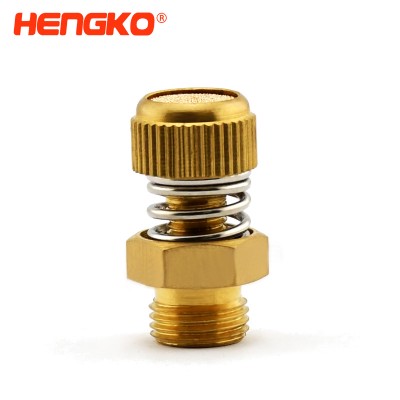
HB Micron Stainless steel Bronze Sintered Filter Element 1/4" Air Pneumatic Flow S...
HD Exhaust Muffler Bronze Model 1/8'' 1/4'' 3/8'' 1/2'' 3/4'' 1'' Pneumatic Sintered Mufflers Filters utitlize porous sintered bronze filte...
View Detail -
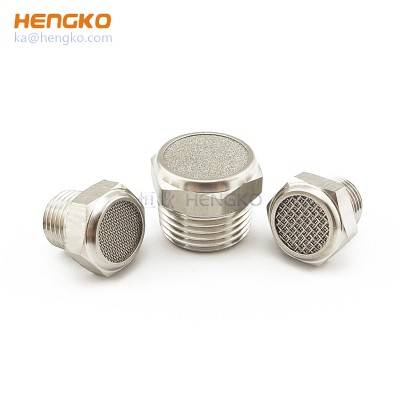
HBSL-MA V sintered brass pneumatic flat silencer muffler air exhaust noise reducing and...
Muffler Silencer Model G M5 1/8'' 1/4'' 3/8'' 1...
View Detail -
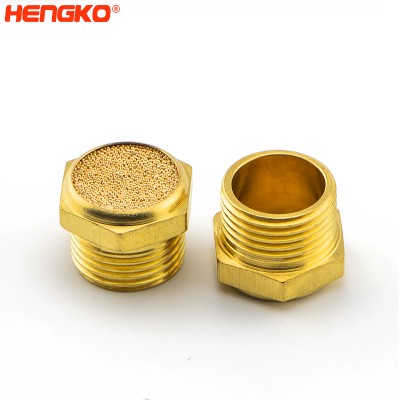
Brass air eliminator pneumatic muffler breather vent with 1/8” 1/4” 3/8R...
Pneumatic Sintered Mufflers Filters utilize porous sintered bronze filter elements secured to standard pipe fittings. These compact and inexpensive mufflers ...
View Detail -
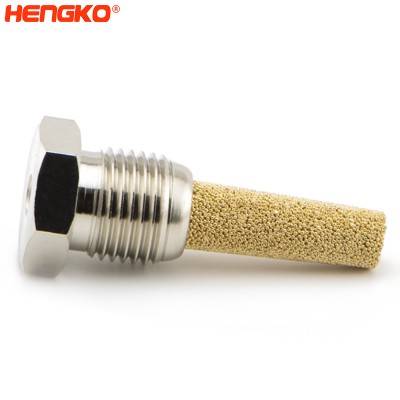
HENGKO Sintered Porous Metal Pneumatic components/ muffler return valve oil filter that...
Oil Valve Filter Bronze Model M5 M5 M5 1/8'' 1/4'' Pneumatic Sintered Mufflers Filters utitlize porous sintered bronze filter ele...
View Detail -
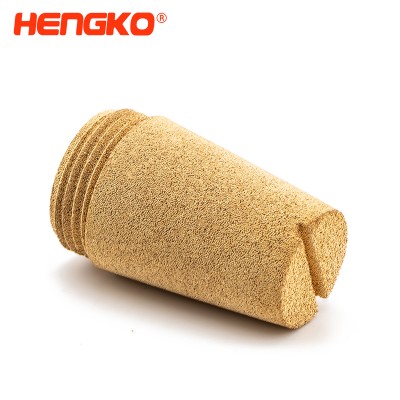
HSC Pneumatic Sintered Stainless Steel Brass Exhaust Muffler Silencer Fitting Noise Fil...
HD Exhaust Muffler Bronze Model 1/8'' 1/4'' 3/8'' 1/2'' 3/4'' 1'' 1-1/4'' Pneumatic Sintered Mufflers Filters utilize porous si...
View Detail -

Porous Metal Sintered Stainless Steel Exhaust Muffler Silencers Flow Control Air Breath...
Pneumatic Sintered Mufflers Filters utilize porous sintered bronze filter elements secured to standard pipe fittings. These compact and inexpensive mufflers ...
View Detail -

Flow control exhaust muffler silencers porous metal sintered stainless steel air breath...
Pneumatic Sintered Mufflers Filters utilize porous sintered bronze filter elements secured to standard pipe fittings. These compact and inexpensive mufflers ...
View Detail -

Microns Pneumatic Plus Sintered Metal Bronze Breather Vent – Brass Body 1/4″...
Pneumatic Sintered Mufflers Filters utilize porous sintered bronze filter elements secured to standard pipe fittings. These compact and inexpensive mufflers ...
View Detail -

Industrial Sintered Porous Stainless Steel Air Silencer OEM and Wholesale
Pneumatic Sintered Mufflers Filters utitlize porous sintered bronze filter element secured to standard pipe fittings. These compact and inexpensive mufflers ...
View Detail -

Custom Pore Size Sintered Stainless Steel Porous Air Silencer
Pneumatic Sintered Mufflers Filters utitlize porous sintered bronze filter element secured to standard pipe fittings. These compact and inexpensive mufflers ...
View Detail -

50um Sintered Stainless Steel Porous Air Silencer Industrial Grade Available Now
Pneumatic Sintered Mufflers Filters utitlize porous sintered bronze filter element secured to standard pipe fittings. These compact and inexpensive mufflers ...
View Detail -

5um Sintered Stainless Steel Gas Flow Restrictor for Laboratory Gas Chromatography Systems
3–5μm Sintered Stainless Steel Gas Flow Restrictor for Laboratory Gas Chromatography Systems and Other Applications Engineered for high-precision gas control...
View Detail -
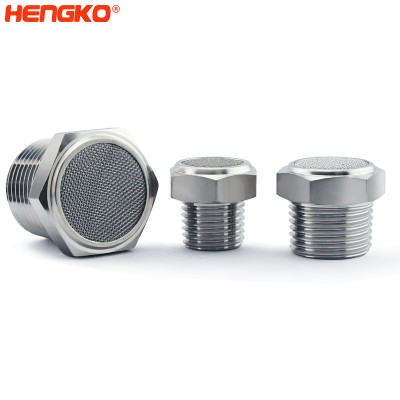
HBSL-SSDM Male Breather Vent Flat Sintered Mesh Pneumatic Air Silencer Mufflers Solenoi...
Pneumatic Sintered Mufflers Filters utitlize porous sintered bronze filter element secured to standard pipe fittings. These compact and inexpensive mufflers ...
View Detail -

Industrial Stainless Steel Mesh Air Silencer with Copper-Nickel Head | Durable & E...
Pneumatic Sintered Mufflers Filters utitlize porous sintered bronze filter element secured to standard pipe fittings. These compact and inexpensive mufflers ...
View Detail -
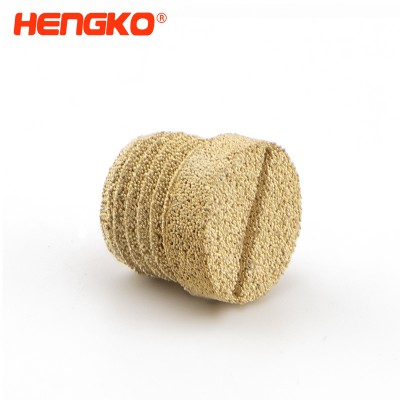
sintered porous metal powder bronze exhaust filter silencers fitting noise filter reduc...
Pneumatic Sintered Mufflers Filters utitlize porous sintered bronze filter element secured to standard pipe fittings. These compact and inexpensive mufflers ...
View Detail
Specifications of Pneumatic Silencer
For the Pneumatic Silencer Specification, usually, we will care 4-point materials, temperature, pressure, and Connection type.
Material Option
You should select a silencer housing material according to the application because the Housing material will influence the silencer strength, environment compatibility, pressure range, and temperature range. The housing material should be considered carefully during selection. The most common housing materials in the Market are sintered brass, sintered plastic, and stainless steel.
1. Stainless Steel
Stainless steel is an excellent choice for applications that require corrosion protection, durability, and operating in a sterile environment. Food or pharmaceutical applications show an example of a stainless steel silencer. Stainless steel is generally more expensive than bronze or plastic silencers.
2. Sintered Brass
Sintered brass is a lower-cost option for durable metal housing. An example of a sintered brass silencer is shown in Figure 3. This material is suitable for non-corrosive and neutral environments.
3. Sintered Plastic
Sintered plastic is low-cost, lightweight, and offers high chemical resistance with higher noise reduction than metal materials. An example of a sintered plastic silencer is shown in Figure 4. This material is suitable for corrosive environments.
As Above introduce, you can know for now, metal silencer is more and more popular, because for sintered metal filter for air have more advantage, such as the frame is strong, Corrosion resistance, high temperature resistance, can use to many harsh environment. so if your pump or valve is used to outdoor harsh environment, we also advice to use sintered stainless Pneumatic Muffler or Brass Silencer.
Temperature
Pneumatic silencers are appropriate for high or low-temperature applications. While selecting the silencer material type, one has to ensure that the material can operate suitably across the operating temperature range of applications.
Pressure
Select a pneumatic cylinder according to the correct operating pressure to ensure optimal noise reduction and reduce premature failure. A silencer's surface area typically impacts the silencer's overall size, mechanical strength, and noise reduction. Hence, selecting the correct pressure is essential to ensure proper machine operation.
Connection Type
Pneumatic silencers are typically connected to ports using a threaded male end, which could be on a pneumatic cylinder, solenoid valve, or pneumatic fittings. A pneumatic silencer allows it to be moved from one hose or device to another.
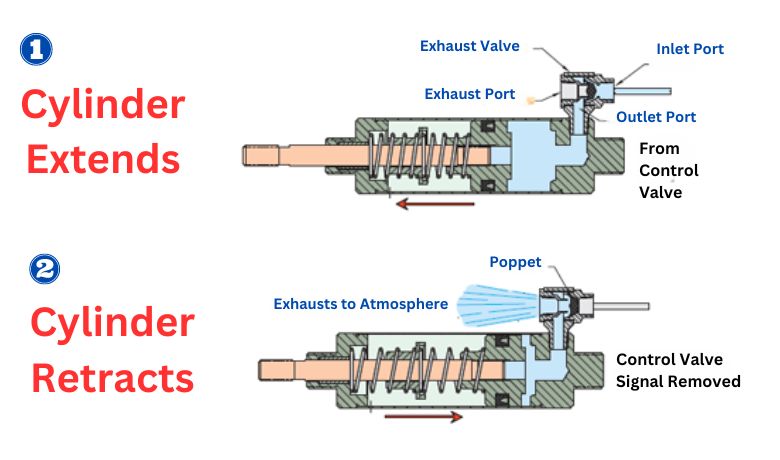
How Does Pneumatic Muffler Work
As we Know A pneumatic muffler, also known as a pneumatic silencer or air muffler, is a device used to reduce or dampen the noise generated by the flow of compressed air or gas in pneumatic systems. It works on the principle of dissipating the energy of the fast-moving air or gas by forcing it through a series of chambers and perforated materials, which helps to decrease the noise level before the air is released into the environment.
Here's how a pneumatic muffler typically works:
-
Inlet Port: The pneumatic muffler is connected to the outlet of a pneumatic device, such as an air compressor, pneumatic valve, or other pneumatic components.
-
Expansion Chamber: The inlet port leads to an expansion chamber within the muffler. This chamber allows the compressed air or gas to expand and slow down, reducing its velocity and consequently lowering the noise level.
-
Perforated Plates or Baffles: Inside the muffler, there are one or more perforated plates or baffle elements. These elements are designed to break up the flow of the air or gas and force it to change direction multiple times. As the air or gas passes through the small holes or gaps in the plates, some of its energy is converted into heat, further reducing the noise.
-
Absorption Materials: Some pneumatic mufflers also contain sound-absorbing materials, such as foam or fiberglass, to help absorb and dissipate additional noise energy. These materials further contribute to noise reduction.
-
Diffuser Section: After passing through the expansion chamber and the perforated plates, the air or gas enters the diffuser section. The diffuser allows the airflow to gradually return to atmospheric pressure, smoothing out the flow and minimizing noise.
-
Outlet Port: Finally, the treated air or gas exits the muffler through the outlet port, with a significantly reduced noise level compared to the initial high-pressure flow.
By incorporating these features, pneumatic mufflers effectively attenuate the noise generated by pneumatic systems, making them more environmentally friendly and compliant with noise regulations. The specific design and effectiveness of a pneumatic muffler may vary depending on its intended application and the level of noise reduction required.
Main Features of Pneumatic Muffler
There are many features and function of pneumatic muffler, it can help us to solve many
problem in industrial production and life, as following is some main features, please check
and hope it will be helpful for you know more details about muffler pneumatic.
-
Noise Reduction: The primary function of a pneumatic muffler is to reduce the noise generated by the flow of compressed air or gas in pneumatic systems. It effectively attenuates the noise level to make the system quieter and more environmentally friendly.
-
Expansion Chamber: Pneumatic mufflers typically have an expansion chamber that allows the high-velocity compressed air or gas to expand, slowing down its flow. This expansion helps to lower the noise level by reducing the impact and turbulence of the airflow.
-
Perforated Plates or Baffles: Inside the muffler, there are usually perforated plates or baffle elements. These components serve to break up the airflow and force it to change direction multiple times. As the air passes through the small holes or gaps in these plates, some of its energy is converted into heat, contributing to noise reduction.
-
Sound-Absorbing Materials: Some pneumatic mufflers incorporate sound-absorbing materials, such as foam or fiberglass, to further dampen the noise. These materials absorb sound energy, converting it into heat and reducing the overall noise level of the system.
-
Diffuser Section: After passing through the expansion chamber and perforated plates, the airflow enters a diffuser section. The diffuser allows the air to gradually return to atmospheric pressure, smoothing out the flow and minimizing noise.
-
Compact and Lightweight: Pneumatic mufflers are typically designed to be compact and lightweight, making them easy to install and integrate into pneumatic systems without adding significant weight or bulk.
-
Durable Construction: They are often constructed from durable materials, such as metal or high-quality plastics, to withstand the operating conditions of pneumatic systems and ensure a long service life.
-
Easy Installation: Pneumatic mufflers are generally designed for easy installation and can be threaded or inserted directly into pneumatic system ports or exhaust openings.
-
Application-Specific Designs: Different pneumatic systems may have specific noise reduction requirements, so pneumatic mufflers come in various designs and configurations to cater to different applications and noise reduction needs.
-
Maintenance-Free: Once installed, pneumatic mufflers typically require little to no maintenance, offering a hassle-free solution for noise reduction in pneumatic systems.
Overall, the main features of a pneumatic muffler make it an essential component in pneumatic systems, ensuring reduced noise levels and compliance with noise regulations, while maintaining the efficiency and functionality of the system.
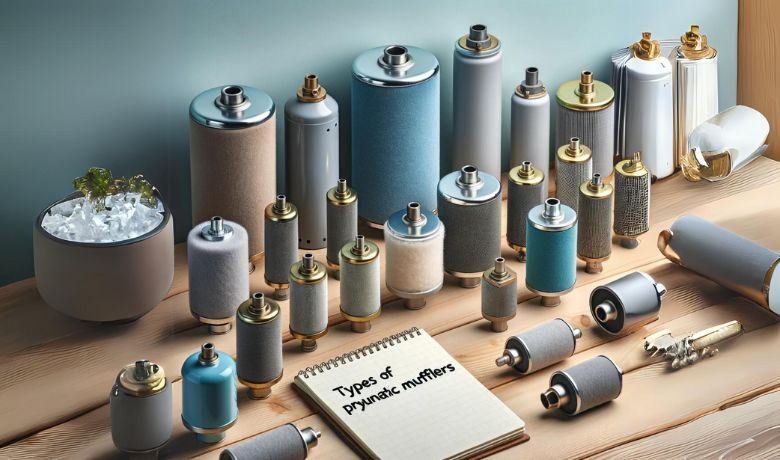
Types of Pneumatic Muffler
There are several types of pneumatic mufflers, each designed to cater to specific noise reduction needs and applications in pneumatic systems. The main types of pneumatic mufflers include:
1. Sintered Bronze Mufflers:
Sintered bronze mufflers consist of a porous bronze material that is formed under high pressure and temperature. These mufflers provide excellent noise reduction by allowing air or gas to pass through the tiny pores, which dissipate the energy and reduce noise. Sintered bronze mufflers are commonly used in pneumatic tools, air cylinders, and exhaust ports.
2. Wire Mesh Mufflers:
Wire mesh mufflers are constructed using tightly woven wire mesh screens that create a labyrinth-like path for the airflow. As the air passes through the small openings in the wire mesh, its energy is dissipated, resulting in noise reduction. These mufflers are suitable for various pneumatic applications, including air compressors and pneumatic control valves.
3. Exhaust Diffuser Mufflers:
Exhaust diffuser mufflers are designed specifically for reducing the noise generated by pneumatic exhaust ports. They have a diffuser section that allows the air to expand gradually, smoothing out the flow and minimizing noise during exhaust. These mufflers are commonly used in pneumatic cylinders and exhaust ports of pneumatic systems.
4. Plastic Mufflers:
Plastic mufflers are made of high-quality plastics, often reinforced with metal elements. They provide noise reduction while being lightweight and corrosion-resistant. Plastic mufflers are used in a variety of applications, including air tools, air valves, and pneumatic control systems.
5. Micro-Porous Mufflers:
Micro-porous mufflers are made from a combination of sintered bronze or stainless steel and sound-absorbing materials, such as foam or fiberglass. This design offers excellent noise reduction capabilities while maintaining a compact size. Micro-porous mufflers are suitable for use in pneumatic instruments, air motors, and other noise-sensitive applications.
6. Adjustable Mufflers:
Adjustable mufflers come with a threaded orifice or an adjustable cap that allows users to control the airflow and, consequently, the noise level. These mufflers provide flexibility in noise reduction and are often used in pneumatic systems where noise requirements may vary.
7. Baffle Plate Mufflers:
Baffle plate mufflers use multiple perforated plates or baffle elements to create turbulence and disrupt the airflow, reducing noise levels effectively. These mufflers find application in various pneumatic systems, including air compressors and pneumatic tools.
8. Venturi Mufflers:
Venturi mufflers utilize a venturi design to expand and slow down the airflow, leading to noise reduction. They are commonly used in exhaust ports of pneumatic cylinders and other pneumatic components.
So. It's important to choose the right type of pneumatic muffler based on the specific noise reduction requirements and the particular pneumatic application it will be used in. Different mufflers may have varying levels of noise reduction and pressure drop characteristics, so selecting the appropriate muffler ensures optimal performance of the pneumatic system.
Why You Should Use Sintered Bronze Muffler ?
There are several reasons why you should consider using a sintered bronze muffler in your pneumatic system:
1. Effective Noise Reduction:
Sintered bronze mufflers are highly effective in reducing the noise generated by the flow of compressed air or gas. The porous structure of the bronze material allows the air or gas to pass through tiny pores, dissipating its energy and lowering the noise level significantly. This makes sintered bronze mufflers an excellent choice for noise-sensitive environments and applications where noise reduction is essential.
2. Durable and Resilient:
Sintered bronze mufflers are known for their durability and resilience. The sintering process creates a solid, interconnected structure, making the muffler resistant to damage from external impacts and vibrations. This durability ensures a long service life, even in demanding industrial environments.
3. Wide Range of Applications:
Sintered bronze mufflers are versatile and can be used in various pneumatic applications. They are commonly employed in pneumatic tools, air cylinders, pneumatic control valves, and other components that require noise reduction.
4. Corrosion Resistance:
Bronze is inherently corrosion-resistant, making sintered bronze mufflers suitable for use in harsh environments and outdoor applications where exposure to moisture or corrosive substances may occur.
5. High Temperature Tolerance:
Sintered bronze mufflers can withstand relatively high temperatures without compromising their performance. This property makes them suitable for use in pneumatic systems that operate under elevated temperature conditions.
6. Uniform and Controlled Pore Structure:
During the sintering process, the pore structure of the bronze material can be controlled and tailored to specific requirements. This allows manufacturers to design mufflers with precise noise reduction capabilities and pressure drop characteristics, ensuring optimal performance in different applications.
7. Compact and Lightweight:
Sintered bronze mufflers are typically compact and lightweight, which means they add minimal weight and size to the overall pneumatic system. This is especially beneficial in applications where space and weight considerations are important.
8. Maintenance-Free Operation:
Once installed, sintered bronze mufflers generally require little to no maintenance. They do not have moving parts or components that need regular attention, providing a hassle-free solution for noise reduction in pneumatic systems.
Overall, the effective noise reduction, durability, corrosion resistance, and versatility of sintered bronze mufflers make them a reliable and practical choice for achieving a quieter and more efficient pneumatic system. Before choosing a muffler, it's essential to consider the specific noise reduction requirements and the intended application to ensure the best match for your pneumatic system's needs.
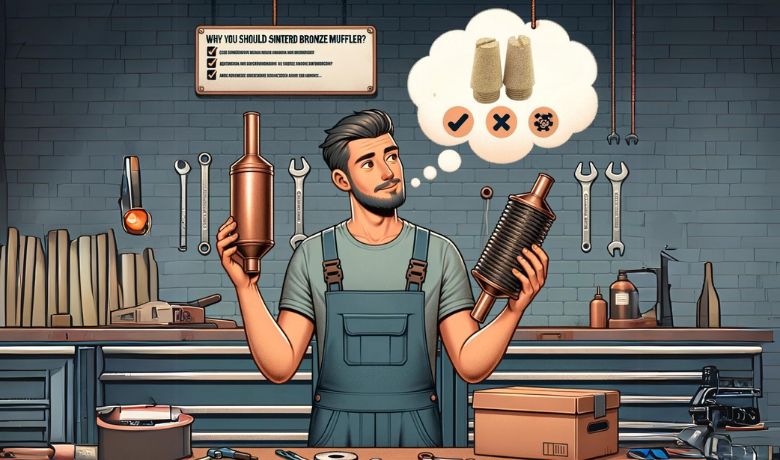
Sintered Bronze Muffler vs Stainless Steel Muffler Pneumatic
How to choose from sintered bronze and stainless steel muffler, Here we list some advantage and features, hope it will be
helpful for you to choose right air muffler pneumatic for your device or project.
Sintered bronze mufflers and stainless steel mufflers are two common types of pneumatic mufflers, each with its own set of
advantages and characteristics. Here's a comparison between the two:
1. Material Composition:
- Sintered Bronze Muffler: Sintered bronze mufflers are made from porous bronze material formed under high pressure and temperature. The porous structure allows air or gas to pass through tiny pores, reducing noise.
- Stainless Steel Muffler: Stainless steel mufflers are made from corrosion-resistant stainless steel. They may have perforated plates or a wire mesh design for noise reduction.
2. Noise Reduction:
- Sintered Bronze Muffler: Sintered bronze mufflers are highly effective in noise reduction due to their porous structure, which dissipates energy and lowers noise levels effectively.
- Stainless Steel Muffler: Stainless steel mufflers also provide good noise reduction, but the level of noise reduction may vary depending on the specific design and configuration.
3. Durability:
- Sintered Bronze Muffler: Sintered bronze mufflers are generally durable and resilient, but they may be more susceptible to damage from high impact or vibration compared to stainless steel mufflers.
- Stainless Steel Muffler: Stainless steel mufflers are known for their excellent durability and resistance to impact, making them suitable for harsh environments.
4. Corrosion Resistance:
- Sintered Bronze Muffler: Sintered bronze mufflers have some level of corrosion resistance, but they may not be as resistant to corrosion as stainless steel mufflers.
- Stainless Steel Muffler: Stainless steel mufflers are highly corrosion-resistant, making them ideal for use in applications exposed to moisture, chemicals, or outdoor elements.
5. Temperature Tolerance:
- Sintered Bronze Muffler: Sintered bronze mufflers can handle relatively high temperatures, but their temperature tolerance may not be as high as stainless steel mufflers.
- Stainless Steel Muffler: Stainless steel mufflers have excellent temperature tolerance, making them suitable for high-temperature pneumatic applications.
6. Weight:
- Sintered Bronze Muffler: Sintered bronze mufflers are generally lightweight and add minimal weight to the pneumatic system.
- Stainless Steel Muffler: Stainless steel mufflers are heavier than sintered bronze mufflers, but the weight difference may not be significant in most applications.
7. Price:
- Sintered Bronze Muffler: Sintered bronze mufflers are often more affordable compared to stainless steel mufflers.
- Stainless Steel Muffler: Stainless steel mufflers tend to be more expensive due to the cost of the material and its corrosion-resistant properties.
8. Application Specificity:
- Sintered Bronze Muffler: Sintered bronze mufflers are widely used in various pneumatic applications, including air tools, air cylinders, and pneumatic control valves.
- Stainless Steel Muffler: Stainless steel mufflers are often chosen for applications that require superior corrosion resistance and high-temperature tolerance, such as in marine or chemical processing environments.
In summary, the choice between sintered bronze mufflers and stainless steel mufflers depends on specific application requirements. Sintered bronze mufflers are generally cost-effective and offer excellent noise reduction, while stainless steel mufflers excel in durability, corrosion resistance, and high-temperature applications.
What is the Main Size of a Pneumatic Muffler on the Market,
What Kind and Size is The kind of Pneumatic Silencers do we supply?
Please check as following Form :
Applications of Pneumatic Muffler
Pneumatic silencers are commonly installed on air valves, cylinders, manifolds, and fittings. Applications that operate pneumatics at a high frequency and produce a large amount of noise are well-suited for pneumatic silencers. The application industry examples below commonly use pneumatic silencers.
1. Packaging:
Pneumatics are often used on packaging machines to drive motion. A sorting machine often diverts products based on a signal from an industrial controller. The signal from the controller is used to activate a pneumatic device. Due to the high rate at which packaging machines operate and the high volume of workers typically surrounding these machines, pneumatic silencers would be well-suited for packaging machines.
2. Robotics:
Robotics frequently use pneumatic to control movement or work on a load. A robotic arm, for example, uses pneumatic to control its motion. Switching on or off pneumatic valves will prevent the movement of the arm. Robotics are commonly used in conjunction with workers, so maintaining the exhaust noise is essential.
3. Fence and Other Big Production Machinery:
Machines that produce rolls of fence often include pneumatic cylinders to cut fencing as it is woven into rolls. An operator is constantly working alongside fence production machinery to ensure the registrations of the fence are according to specification. To protect operators from damaging noise, a pneumatic silencer is an ideal solution to reduce noise from the constantly operated machinery.
4. Automotive industry:
Pneumatic mufflers are widely used in the automotive industry to reduce noise from air-powered systems, such as engine compressors and pneumatic brakes.
5. Manufacturing industry:
Pneumatic mufflers are commonly used in manufacturing facilities to reduce noise from pneumatic tools and equipment, such as pneumatic drills and presses.
6. Aerospace industry:
In the aerospace industry, pneumatic mufflers reduce noise from air-powered systems in aircraft and spacecraft.
7. Medical industry:
Pneumatic mufflers are used in medical equipment, such as air-powered surgical tools, to reduce noise and improve patient comfort.
8. Food and beverage industry:
Pneumatic mufflers are used in food and beverage processing facilities to reduce noise from air-powered conveyors, mixers, and other equipment.
9. Power generation industry:
Pneumatic mufflers are used in power generation facilities to reduce noise from air compressors and other pneumatic systems.
10. Petroleum and chemical industry:
Pneumatic mufflers are used in the petroleum and chemical industries to reduce noise from air-powered pumps and other equipment.
11. Construction industry:
Pneumatic mufflers are used in the construction industry to reduce noise from air-powered tools, such as jackhammers and pneumatic nail guns.
What projects you like to use or OEM Pneumatic Muffler ? Contact us and get fast and best solution.
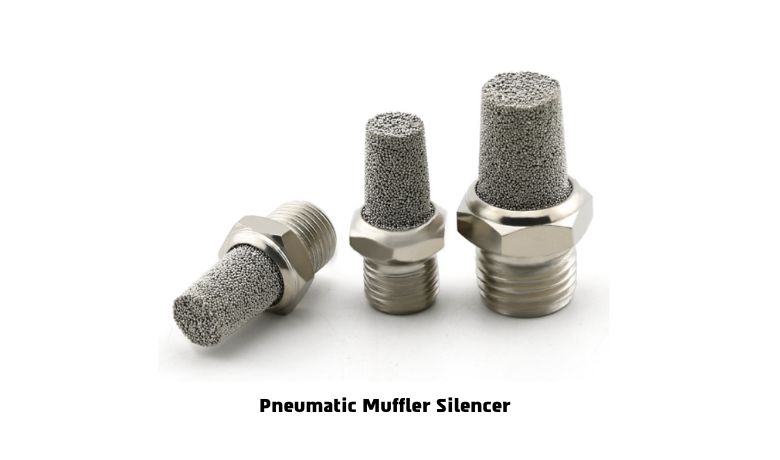
How to Choose a Pneumatic Muffler
Before selecting a pneumatic muffler, make sure you're familiar with these three points:
Airflow The muffler's maximum airflow (SCFM) must be equal to or greater than the flow of the device on which it is installed. It avoids excessive air restriction, a key to maintaining satisfactory performance. Ensure that the pneumatic muffler's airflow capacity equals the flow rate specified by the pneumatic tool, valve, or another equipment manufacturer. If these data are unavailable, choose a muffler with a thread at least equal in diameter to the port of the tool or equipment.
1. The material used to make the body and filter
Choose a muffler made of stainless steel or plastic in a highly corrosive environment.
2. The type of equipment used and the available space
Mufflers come in different sizes. To determine the right muffler size, consider the pressure of the air blast and the type of equipment. Some dampers are designed for higher working pressures or to prevent excess air blasts, like those for air exhaust or relief valves. These mufflers generally are more "massive" and provide enhanced noise reduction. In contrast, more compact mufflers that meet different performance criteria are ideally suited to smaller spaces, especially at the outlet of a valve.

People Also Ask
1. What is a Pneumatic Silencer?
A Pneumatic Silencer, also known and called as Air Pneumatic Mufflers, functions as an outlet to vent pressurized air to the atmosphere. A silencer is commonly fitted on pneumatic cylinder, pneumatic fittings, or 5 or 2-way solenoid valves. The air leaving the device emirates contaminants during operation, but it may produce noise that may be harmful to the surrounding. Hence, it’s advisable to use a silencer exhaust cleaner to inhibit damaging contaminants from entering the environment.
Pneumatic air silencers are very cost-effective and a much simple tool to decrease the noise level and unwanted release of contaminants from pneumatic. Silencer also comes with an adjustable flow rate control that can be used to control the speed of a driving device. So for the pneumatic silencer, the main function is reduce the noise of the high pressure air.
You Can also to check our article to know more details "What Is A Pneumatic Muffler?"
2. How Do Pneumatic Silencers Work?
The primary function of pneumatic silencer is to outlet pressurized air at a safe noise level and to prevent contaminants from exiting the silencer (if it is combined with a filter). Silencers are fitted directly at the exhaust port of a valve and diffuse the unconfined air through a bigger surface area which decreases turbulence and thus drops noise levels.
Silencers can also be installed on hoses. There are three most common types of cylinder, which as stainless steel silencers, brass silencers and plastic silencer. actually, stainless steel silencers is more and more popular because price is reasonable and durable , and brass silencer is cheaper, for the plastic silencer main used to the devices not have so high pressure out.
3. What is the Difference Between a Silencer and a Muffler?
A pneumatic silencer and pneumatic muffler refer to the same device.
The term silencer is commonly used in British English, Whereas the term muffler is commonly used in America.
4. How Does an Air Muffler Improve Pneumatic System Performance?
An air muffler reduces noise levels generated by compressed air flow in pneumatic systems. By dissipating the air flow and reducing its velocity, the air muffler ensures the system operates quietly and efficiently, which is especially important in industrial environments where noise reduction is a priority.
5. Need I Clean My Silencer ?
Actually, Clean is very important, but It is recommended to routinely clean silencer threads and the housing exterior depending on usage.
Dirt and dust can build inside the threads or housing of silencers, especially in polluted exhaust environments. This prevents damage from
blockages and reduces the possibility of downtime.
6. How Can I Ensure My Silencer Install Fine and Tight?
Depending on the frequency and pressure requirements of your application. A sealant can be applied to the thread of the silencer to ensure it remains tight during operation.
7. What is the Optimal Mounting Direction ?
Proper installation is very important to the life of the muffler, Silencers should be mounted such that contaminants do not block the silencer or exhaust port. For example, a horizontally mounted silencer will allow contaminants to drain through the silencer using gravity. This prevents damage from blockages.
8. Where is the muffler used in the pneumatic system?
In a pneumatic system, a muffler is used to reduce the noise generated by the airflow. Pneumatic systems typically consist of compressors, valves, fittings, and actuators that generate noise as air moves through them. The muffler helps to mitigate this noise by using a series of chambers, baffles, and porous materials to absorb and dissipate the sound waves. Mufflers can be used on both the intake and exhaust sides of the system to provide a more quiet and pleasant working environment.
9. Are pneumatic cylinders loud?
Pneumatic cylinders can be loud, especially if they are not properly muffled. The sound generated by pneumatic cylinders can be caused by the sudden release of air pressure, the piston's movement, or the cylinder body's vibration. To reduce this noise, manufacturers often provide mufflers that can be attached to the cylinder. Mufflers absorb and dissipate the sound waves before they reach the surrounding environment. However, mufflers can only do so much, so it's important to consider the noise level when selecting a pneumatic cylinder.
10. What is a muffler in a hydraulic system?
In a hydraulic system, a muffler is a device used to reduce the noise generated by the flow of hydraulic fluid. Hydraulic systems typically consist of pumps, valves, and actuators that generate noise as the fluid moves through them. The muffler helps to mitigate this noise by using a series of chambers, baffles, and porous materials to absorb and dissipate the sound waves. Mufflers can be used on both the intake and exhaust sides of the system to provide a more quiet and pleasant working environment.
11. What's the difference between a muffler and a silencer?
Muffler and silencer are often used interchangeably, but they can have slightly different meanings depending on the context. In general, a muffler refers to a device designed to reduce the noise generated by air or fluid flow. On the other hand, a silencer is a device designed to completely eliminate or significantly reduce the sound of a specific noise source, such as a firearm.
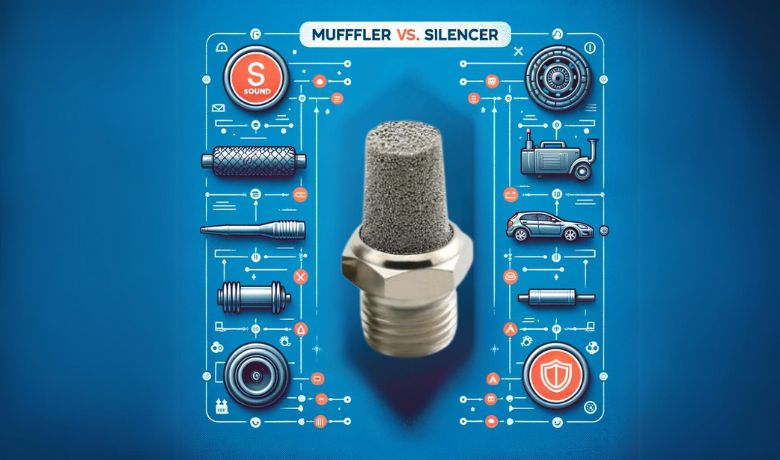
12. What is the most common muffler type?
The most common muffler type is the resonator muffler. Resonator mufflers use a series of chambers and perforated tubes to absorb and dissipate the sound waves generated by air or fluid flow. They are typically made of steel or aluminum and are easy to install and maintain. Other types of mufflers include the chambered muffler, the glass pack muffler, and the turbo muffler. Each muffler type has unique characteristics and is designed for specific applications.
13. What type of exhaust sounds the best?
The type of exhaust that sounds the best is subjective and depends on personal preference. Some people prefer the deep, aggressive sound of a straight-pipe exhaust, while others prefer the smoother, more refined sound of a muffled exhaust. The sound of an exhaust system is influenced by several factors, including the type of muffler, the size of the pipes, and the engine's RPM. It's best to experiment with different exhaust systems and mufflers to find the one that sounds best to you.
14. How Does an Air Muffler Improve Pneumatic System Performance?
An air muffler reduces noise levels generated by compressed air flow in pneumatic systems. By dissipating the air flow and reducing its velocity, the air muffler ensures the system operates quietly and efficiently, which is especially important in industrial environments where noise reduction is a priority.
15. Can I Find a Wide Range of Mufflers on Amazon?
Yes, Amazon offers a diverse selection of mufflers, including exhaust mufflers, air mufflers, and pneumatic mufflers. You can easily find a muffler that meets your specific requirements and budget by browsing through the available options and reading customer reviews.
16. What is the Function of an Exhaust Cone in a Muffler System?
The exhaust cone plays a crucial role in directing the flow of exhaust gases and sound waves within the muffler, aiding in the noise reduction process. The cone's design helps to enhance the muffler's overall performance in minimizing exhaust noise.
17. How Do Exhaust Silencers Contribute to Environmental Compliance?
Exhaust silencers are essential in reducing noise pollution from machinery and vehicles. They help industries comply with environmental regulations and standards by minimizing the impact of noise on surrounding communities and the environment.
18. Where Can I Find a Muffler Repair Shop Nearby?
To locate a muffler repair shop nearby, you can use online directories, search engines, or local business listings. Additionally, you can ask for recommendations from friends or family to find a reputable shop in your area.
19. What Makes Pneumatic Mufflers Essential in Compressed Air Systems?
Pneumatic mufflers are crucial in reducing noise generated by the exhaust of compressed air in pneumatic systems. They contribute to a safer and more comfortable work environment by ensuring the system operates with minimal noise.
20. Why is an Air Exhaust Muffler Important in Industrial Settings?
An air exhaust muffler is important in industrial settings as it significantly reduces noise levels produced by air exhaust systems. This contributes to compliance with workplace safety regulations and enhances the overall work environment.
21. How do Valve Mufflers Improve the Performance of Pneumatic Systems?
Valve mufflers are installed at the exhaust ports of air valves to minimize noise produced during the exhaust process. By reducing air turbulence and dissipating air flow, valve mufflers enhance the efficiency and quietness of pneumatic systems.
22. What is the Difference Between a Pneumatic Silencer and a Muffler?
The terms pneumatic silencer and muffler are often used interchangeably. Both refer to devices designed to reduce noise in pneumatic systems by dissipating air flow and reducing its velocity, thus minimizing noise levels.
Still Have Questions for the Pneumatic Muffler ?
You Are Welcome to Contact Us by Email ka@hengko.com , or You can also
send inquiry by following form. We will send back with introduce products and solution for your devices
within 24-Hours.
